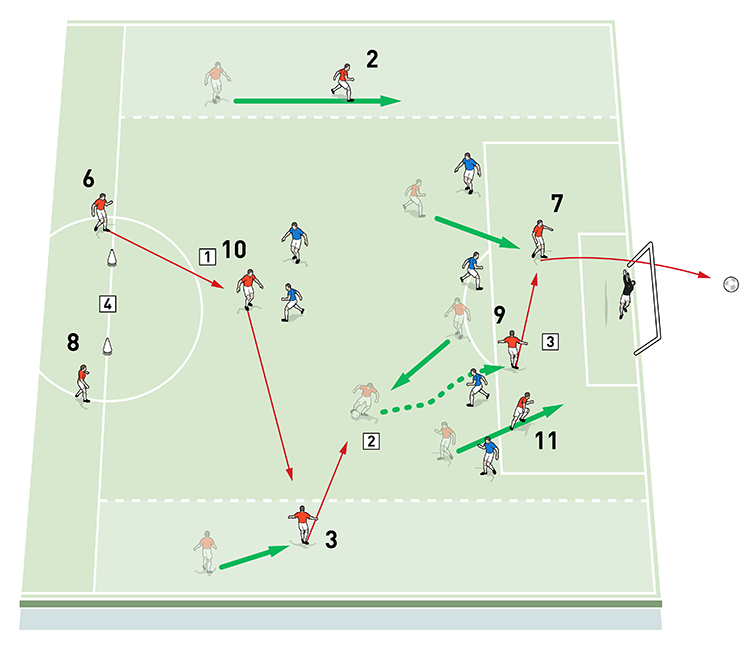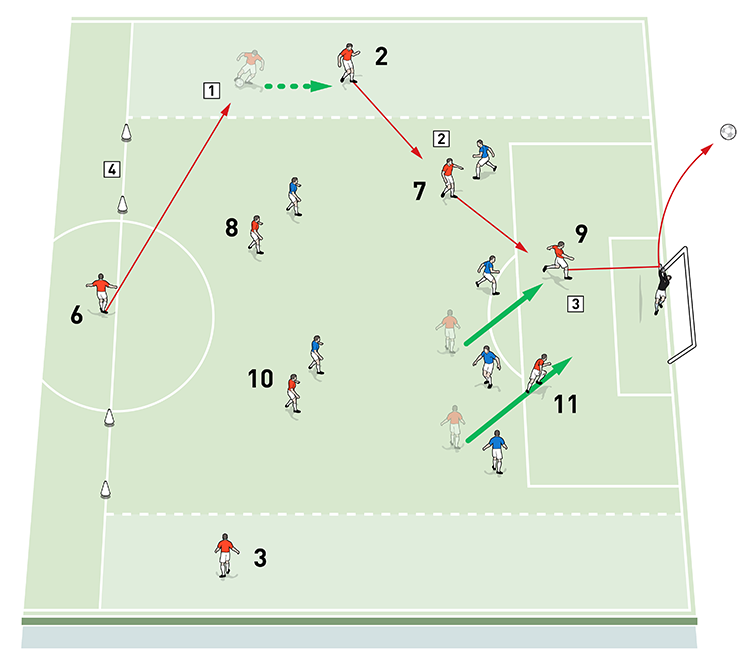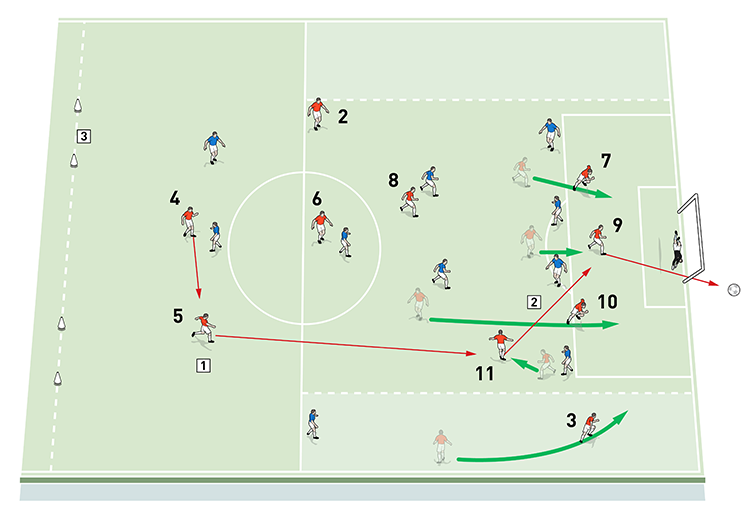You are viewing 1 of your 1 free articles
Attacking in pockets
Due to personnel, the way my teams have played doesn’t support many attempts on target from crosses, so this session encourages creativity, good combination play, intricate passing and concise movement in tight areas.
| Area | Up to three quarters of the pitch |
| Equipment | Balls, bibs, cones, 1 full size goal |
| No. of Players | Up to 20 players + 1 goalkeeper |
| Session Time | In the pocket 1: 15mins, In the pocket 2: 15mins, In the pocket 3: 30mins |
This was a session that I first ran with Norwich City’s U15s but I adapted it to use in the Bangladesh Premier League with Mohammadan Sporting Club.
I needed to use it because the players weren’t stretching opponents with runs in behind, which can allow movement into pockets in front of the back four to create scoring opportunities in key danger areas.
I like this session because when I run it I am fully engaged in controlling the tempo and enthusiasm of the players through the execution of the passing and the timing. It teaches players decision making and shows them when, how and why to play into the pockets.
Due to personnel, the way my teams have played doesn’t support many attempts on target from crosses, so this session encourages creativity, good combination play, intricate passing and concise movement in tight areas.
I would run this session twice a week due to the technical and physical outcomes complementing a normal build up session and of course tactically it is part of an overall strategic game plan as well. It forms a key part of my football philosophy and exemplifies the way I like to play the game.
Of course, if the forthcoming opponents or the playing personnel available don’t suit the technical attributes, then we may adapt it.
IN THE POCKET 1
We set up on half a pitch with a goal and a goalkeeper positioned at one end. Unopposed wide channels are marked on each flank and a small cone goal is marked out on the halfway line. We’re using 14 outfield players, split into an attacking team of eight and a defending team of six.
Play starts with the defensive midfielder passing to the number 10, who drops deep to pick up the ball and play. The number 10 then passes right to the full back in the wide channel and the full back plays a pass into the pocket, which is the space behind the opposition midfield and in front of the opposition back four. If the quick pass into a pocket isn’t on then we can recycle via the full backs to a holding midfielder and switch play with emphasis on quick passing and movement.
What we’re looking for is for the pocket player to use the space well and to make a positive, attacking pass in one or two touches. As shown [1], the pocket player receives on the half turn and, within a couple of touches, passes to a player attacking the box.
1

2. The right back plays a pass into the pocket
3. The pocket player receives on the half turn and, within one or two touches, passes to another attacker to create a scoring chance
4. If the defending team wins the ball, they must immediately pass through the coned goal on the halfway line
If the defending team wins the ball, they play direct and try to score in the cone goal on the halfway line.
After each ball is dead, reset and play again, varying the wing of attack. We play for 15 minutes.
IN THE POCKET 2
We set up the playing area as before, but this time two cone goals are marked on the halfway line. We’re still using 14 outfield players, split into an attacking team of eight and a defending team of six.
The attacking play is more direct in this activity.
A starting pass is made from the defensive midfielder straight to the full back and the opposition can now engage in the wide areas after the first touch. The full back quickly passes into a player in the pocket in front of the opposition defence. The pocket player should then create a scoring opportunity for one of the other attackers, as shown [2].
2

2. The full back passes to a team mate in the pocket
3. The pocket player uses the space to set up one of the other attackers for a shot on goal. The whole attack should take no more than four or five seconds
4. If the defending team wins the ball, they can pass into either of the two coned goals on the halfway line
Play must be quick and it should take no more than four or five seconds from the defensive midfielder’s starting pass to getting a shot away on goal.
If the defending team wins the ball, they can score in either of the two coned goals on the halfway line. Reset after each attack and play for 15 minutes.
IN THE POCKET 3
Now we set up on three quarters of the pitch, with a goal and a goalkeeper at one end and two cone goals at the other end. We’re using 20 outfield players split into two teams of ten, set up in match formations.
Play starts with the attacking team’s centre backs and we look for the ball to be moved tactically up the pitch and into wide areas to create scoring chances. If the opposition block a wide area, then we play central but still look for quick movement into pockets. The full backs can take one touch before the defending team is allowed to close down into the wide area. Players should utilise the quick play in the pocket that they learnt in the previous activities, as shown [3]. If the defending team wins the ball, they try to score by passing into one of the coned goals in the other half.
3

2. Players should use quick play in the pocket to set up scoring chances
3. If the defending team wins possession, they must try to score by passing into one of the two coned goals in the other half
This practice is aimed at players of both elite academy level and players in developing countries, as it paints a picture of a structure that may be new to that group of players.
Reset after each attack and play for 30 minutes.
Related Files
Editor's Picks
Deep runs in the final third
Using the goalkeeper in build-up play
Pressing principles
Intensive boxes drill with goals
Penetrating the final third
Creating and finishing
My philosophy
Pressing initiation
Compact team movement
Coaches' Testimonials

Alan Pardew

Arsène Wenger

Brendan Rodgers

Carlos Carvalhal

José Mourinho

Jürgen Klopp

Pep Guardiola

Roy Hodgson

Sir Alex Ferguson

Steven Gerrard
Coaches' Testimonials

Gerald Kearney, Downtown Las Vegas Soccer Club

Paul Butler, Florida, USA

Rick Shields, Springboro, USA

Tony Green, Pierrefonds Titans, Quebec, Canada
Join the world's leading coaches and managers and discover for yourself one of the best kept secrets in coaching. No other training tool on the planet is written or read by the calibre of names you’ll find in Elite Soccer.
In a recent survey 92% of subscribers said Elite Soccer makes them more confident, 89% said it makes them a more effective coach and 91% said it makes them more inspired.
Get Monthly Inspiration
All the latest techniques and approaches
Since 2010 Elite Soccer has given subscribers exclusive insight into the training ground practices of the world’s best coaches. Published in partnership with the League Managers Association we have unparalleled access to the leading lights in the English leagues, as well as a host of international managers.
Elite Soccer exclusively features sessions written by the coaches themselves. There are no observed sessions and no sessions “in the style of”, just first-hand advice delivered direct to you from the coach.









